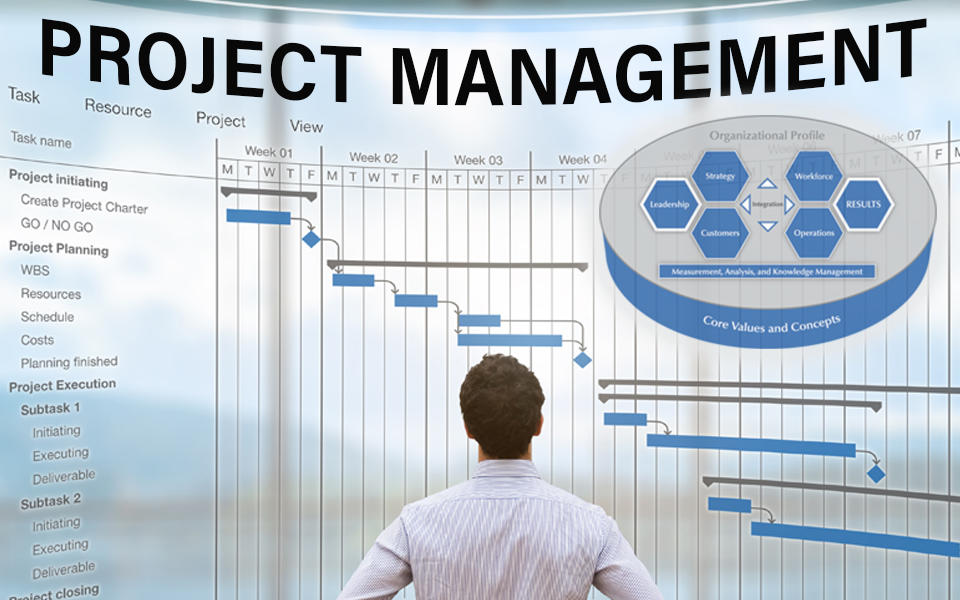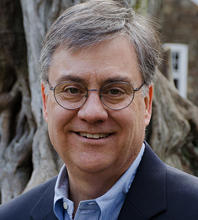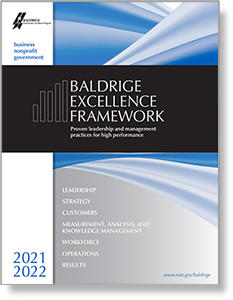Blogrige
The Official Baldrige Blog


Any project, large or small, will require planning and strategy. Project managers or collaborative teams need to not only plan and strategize but to lay a foundation and structure for the project, lead with a clear vision, recognize success from a customer viewpoint, measure progress, understand resource needs, and ensure standardization. Consideration of all of these components are already present in the Baldrige Excellence Framework®, said Jim McLaughlin, author of a blog on “Baldrige for Project Management,” in which he recommends “a detailed review of the framework is highly recommended, but [breaks down] the seven major elements of the framework [and how they might apply to your projects].”
In a virtual interview, Jim explained how the Baldrige framework can serve as a great tool and provide a structure for project managers.
What’s your experience with the Baldrige Performance Excellence Framework and Baldrige in general?
I was introduced to the framework and the Malcolm Baldrige National Quality Award (MBNQA) program when I worked at Boeing. I incorporated the ideas into my R&D project management process.
At about the same time, I led the V-22 Osprey Program's knowledge management effort, so I became steeped in knowledge sharing, knowledge networks, and how best practices and learning were embedded within processes and tools across every discipline.
A big question for me, as an R&D manager, arose around, “How do you know that your project is well-defined, that it will demonstrate the right, measurable progress, and that it will be effective on all of the factors that various stakeholders care about. Is your project correct, and is it robust?”
What led you to connect project management, especially planning and strategy, to the framework?
I had become sort of a student of philosophy, of creativity and innovation, and of project management as I grew to take on both professional and public service leadership roles. The issues faced were not really new or unique and many had been addressed by others through the development of systematic processes that embed knowledge gathered and curated over decades.
As I continued to grow, I came to appreciate that the project manager has to almost totally conceive of a project from the very beginning to the end, not to limit creativity, but to be receptive to how the project might turn, for good or bad. It involves risk management and strategic thinking about where resources or other externalities might affect the project.
The framework embeds this forward thinking into its expectations at each stage and asks questions now that are based on learning and risk mitigation strategies developed over many programs, organizations, leadership styles, etc.
As project managers gets started, they need to rely on frameworks of knowledge that can help them avoid problems by structuring projects in ways that reflect all of the prior learning.
Please share some examples of types of projects that benefited from the considerations in the framework in terms of the project profile (Organizational Profile) and individual components?
I was in a position to manage many, simultaneous projects, so a system of structuring and managing projects, a system that my R&D engineers and scientists could work within and also plan for, was essential to efficient use of funds. The concepts of the framework helped me to establish those common programmatic elements that would be set up and, as a result, I would know that we had covered the “big rock” priorities and avoided obvious risks.
Toward the end of my career, I led the engineering and proposal development for a complex, multi-billion-dollar U.S. Navy program that involved multiple stakeholders--all looking for different outcomes, both near term and long term. As the framework demonstrates, we have to listen to a wide range of stakeholders to address the considerations of each element. Ultimately, to satisfy all of these stakeholders, I offered a strategic design strategy that split up the program offering into both near- and long-term options that met the greatest number of these needs. This showed our near-term ability to deliver and our long-term capability to grow performance through strategic pre-planning. It's never one thing that wins a big program, but I firmly believe that we won this program because of this demonstration of flexibility and creativity supported by a systematic approach to program design--something that precedes even program management, but that is clearly built on the same concepts.
Why do you think it’s beneficial to share ways to use the Baldrige framework?
In my role, I often had to be the program manager before the real program manager stepped in. I was in the new business end of things, but I knew I had to hand off a program plan, budgets, schedules, risks, and everything else needed that could be "executable" within the organizational guidelines for program management and within the terms and expectations of a complex government customer and a diverse corporate skill base. The framework becomes a checklist for quality program definition and opens up avenues for conversations about key program goals, resources, and, very importantly, focus on the outcomes in an efficient, effective way.
What else would you like to share?
Like many skills, project management is a language and there is a wealth of systematic process knowledge that is available to all project managers that can help them avoid problems and set up a project for success. Over the years, I developed a list of about 13 focused questions I could ask about any project that would tell me whether all of the necessary factors were considered, and the framework questions are certainly part of that. Each element of the framework is a question that must be addressed and answered with clarity and collaboration.
I think one of the most powerful features of the framework is the focus on both employees and customers. We know that outcomes are measured by customers, but lasting outcomes, the ones that grow a company and build lasting relationships, involve employees, suppliers, and partners, too. When a project considers all of its stakeholders, it's far more likely to develop a win-win-win atmosphere where everyone sees the benefit of their work and wants to give that critical extra bit of effort toward success.
A project manager, like an organizational leader, can do all of the same things within their project's purview, and the skills developed only help with personal and professional growth. The Baldrige Excellence Framework® is a piece of U.S. intellectual property that needs broad distribution, so I am happy to promote it to a new level and generation of leader through my blog post.

Baldrige Excellence Framework®
The Baldrige Excellence Framework has empowered organizations to accomplish their missions, improve results, and become more competitive. It includes the Criteria for Performance Excellence, core values and concepts, and guidelines for evaluating your processes and results.
Purchase your copy today!
Available versions: Business/Nonprofit, Education, and Health Care





